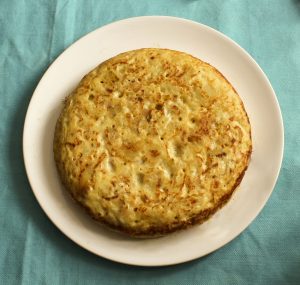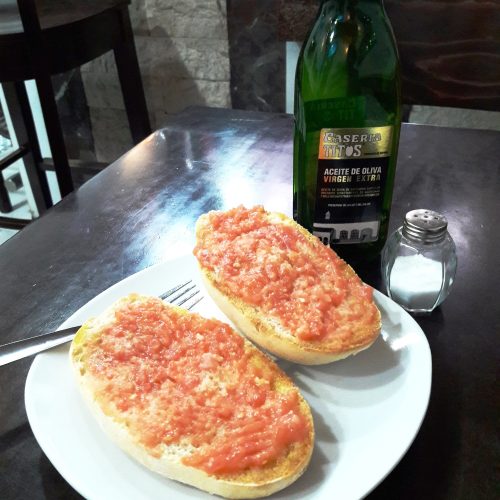
How to: Make Spanish Tortilla de Patatas
Dear Tom,
Just so you know, this article is not to give you a recipe (although we will include Claudia’s recipe at the end) but to help you understand what tortilla de patatas is and the importance it has in Spain. Also known as a tortilla española or tortilla de papas in Spanish and a Spanish omelette in English, this dish can be found in almost any bar or restaurant in Spain and you can usually buy it at most times of the day. Along with many Spaniards, you might even consider that the tortilla española is the official dish of Spain both because they love it and eat it a lot! One time, when hosting an international dinner, seven of the fifteen-odd people invited brought along a Spanish omelette. You can imagine that we laughed a lot and then enjoyed the different versions.
Note: Not to be confused with a Mexican tortillas, in Spain tortilla means omelette. A basic egg omelette is a French one (tortilla francesa) and one that includes potatoes is a Spanish one. You can also have lots of other kinds of tortillas, but these are the main versions you will find in your average bar across Spain.
 The History:
The History:
The exact origin of the Spanish omelette isn’t known, although many stories exist about how it was invented. What we do know is that potatoes arrived in Spain in the early 1500s and about halfway through the century were determined safe for human consumption. This timeline allows for plenty of margin between arrival in Spain and the stories about the first tortilla de patatas around the end of the 1700’s/beginning of the 1800’s.
What there does seem to be relative agreement about is that the development of the dish was due to the need for poor country folk to have access to easy, nutritious meals. When you make your own, you will see that eggs seem to multiply when cooked with potatoes, making it a logical and healthy meal option for farmers and military alike.
The Ingredients:
A basic Spanish omelette requires just the simplest ingredients: eggs, potatoes, seasonings (salt and maybe pepper), and oil (extra virgin olive oil if you’re trying to be true to its roots, although we do know Spaniards who use sunflower oil). An additional ingredient is either considered as necessary or (almost) sacrilegious—onion. Those who love onion in their tortillas will always add it and those who don’t like it will spurn the tortillas that include it. As you will see below, Claudia tends to add in onion to her tortillas but we are both happy to eat it both ways!
 Some people say that the hardest part of making the tortilla is peeling and cutting the potatoes. While we don’t necessarily believe this (the flipping bit is difficult as well), the prep work is pretty straight forward. Potatoes and onions—if you decide you are an onion person—should be sliced or chopped and then slowly fried or cooked down in the oil. They are then added to the beaten eggs and either poured back into the frying pan used for the potatoes without the oil directly or after resting in the eggs for an indeterminate amount of time (depending on the recipe).
Some people say that the hardest part of making the tortilla is peeling and cutting the potatoes. While we don’t necessarily believe this (the flipping bit is difficult as well), the prep work is pretty straight forward. Potatoes and onions—if you decide you are an onion person—should be sliced or chopped and then slowly fried or cooked down in the oil. They are then added to the beaten eggs and either poured back into the frying pan used for the potatoes without the oil directly or after resting in the eggs for an indeterminate amount of time (depending on the recipe).
For us, the next step is the hardest to learn and master. Once the underside of the tortilla is cooked through (hopefully without sticking), you will have to flip it onto a plate or another pan to be able to cook the top—doing this correctly is especially important because unlike an Italian frittata, a Spanish omelette should still be soft (if not a little bit runny on the inside). Once both sides are cooked evenly, you are ready to cut and serve warm or let the tortilla rest and serve cold.
The Tools:
You can probably make a tortilla de patatas with the tools you already have in your house (or even if you are traveling and at a hostel). Nothing fancy is needed, just a way to peel and cut the potatoes, a bowl for the eggs—that the potatoes fit into as well—, a pan to cook the potatoes and tortilla in, and a plate or another pan to flip the tortilla. What you might need is a little bit of practice to be able to flip the omelette like a pro. And, if you don’t want to mess about with this part of the process, you can buy pans called “double pans” made specifically for flipping your tortilla de patatas, such as this one here.
Part of a meal or a Bocadillo
The great thing about the Spanish omelette is that it can be used for almost all meals or snacks throughout your day (although, we wouldn’t recommend only eating tortillas all day, everyday). We have seen people happily eat a slice for breakfast—between the eggs and potatoes, it will fill you up—, tortilla with salmorejo is a classic lunch or light dinner option, and between two slices of bread you have a sandwich that is perfect for your afternoon snack.
The tortilla de patata can easily be dressed up or down. It is not uncommon to find it in the bar next to the train station (where you know that it will be greasy but still decent) or in fancy restaurants. It oftentimes plays a role in tapas or pintxos and can be made with additional ingredients such as red or green peppers, chorizo, mushrooms, etc.
CLAUDIA’S RECIPE
Ingredients:
- 5 to 6 medium potatoes, washed (either with the skin on or peeled)
- 1 medium onion, peeled
- 6 to 7 eggs depending on how big the potatoes are
- A pinch of salt
- 2 to 3 tablespoons of olive oil
Preparation:
- Cut the potatoes and onions into small pieces to help them cook quickly and get quite soft.
- Heat over medium heat enough olive oil to cover the bottom of the pan and, once it is warm add the onions.
- Once the onions are soft, add the potatoes and allow to cook slowly for 20 to 30 minutes or until very soft and almost mushy.
- In a medium bowl add your 6 or 7 eggs and whisk them until well mixed. You want to make sure that you have enough eggs to cover all of your potatoes but not too many that the dish is only eggs. Add your pinch of salt here and whisk it in.
- Once your potatoes and onions are cooked down, add them into the bowl with the eggs and mix together.
- Place your pan back on the stove, over medium heat, and add the potato, onion, and egg mixture back into it. You probably don’t need extra olive oil here but you can always add a bit more if you are worried about sticking.
- Let the bottom of the tortilla cook until it looks fairly solid all along the edges and mostly cooked even on the top.
- Slide the tortilla from the pan onto a plate so that the cooked bottom is on the plate. With the plate in one hand, place the pan over the top and flip the tortilla back into the pan so that what was the top is now on the bottom.
- Cook for five-ish minutes longer until the tortilla is cooked all the way through.
- Slide it back on to a plate and serve warm or allow to cool.
Have you tried a Spanish omelette? Are you an onion or no onion eater?? Let us know your tortilla de patata preferences down below!
Sincerely,
Spain




